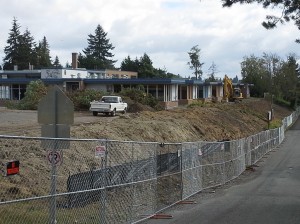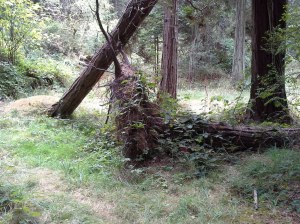It seems you can’t go around a corner in a discussion about environment in Seattle these days without hearing about trees. Trees are in the news. Finally.
 There are the headline making stories like the removal of a dozen mature sweet gum trees in front of a school that was recently closed, but is now going to be reopened. So, they had to cut down the trees. SDOT is the one pushing this one, and it’s about the safety of school children in a bus zone. There’s nothing that makes everybody happy in this mess. That variety of tree should never have been planted there.
There are the headline making stories like the removal of a dozen mature sweet gum trees in front of a school that was recently closed, but is now going to be reopened. So, they had to cut down the trees. SDOT is the one pushing this one, and it’s about the safety of school children in a bus zone. There’s nothing that makes everybody happy in this mess. That variety of tree should never have been planted there.
 Then there is the removal of 13 mature alders in Carkeek Park by Seattle Parks. The issue there is salmon. The trees are a danger to people and to potential salmon habitat. Washington Department of Fish and Wildlife as well as Green Seattle Partnerships, in conjunction with Seattle Parks, will take care of “fixing” things.
Then there is the removal of 13 mature alders in Carkeek Park by Seattle Parks. The issue there is salmon. The trees are a danger to people and to potential salmon habitat. Washington Department of Fish and Wildlife as well as Green Seattle Partnerships, in conjunction with Seattle Parks, will take care of “fixing” things.
 In Kent, not too far from Seattle, the city is planning to cut down 100 forty year old maple trees because they are messing up sidewalks, streets, and storm drains.
In Kent, not too far from Seattle, the city is planning to cut down 100 forty year old maple trees because they are messing up sidewalks, streets, and storm drains.
I guess the question in all of those stories would be – who was making the decisions to place/leave these trees where they would ultimately need to be destroyed? I can only hope we are smarter, 30 to 50 years later, and that we are thinking more than 10-20 years into the future, or not at all.
 Another place where the loss of trees will be slower, but nonetheless the same; our parks and planned recreation areas, where trees are left with no understory. In Lincoln Park in 2006, there was a wind storm in a picnic area bordering two beautiful ballfields, and a couple of large trees came down, in the middle of a picnic/play area.
Another place where the loss of trees will be slower, but nonetheless the same; our parks and planned recreation areas, where trees are left with no understory. In Lincoln Park in 2006, there was a wind storm in a picnic area bordering two beautiful ballfields, and a couple of large trees came down, in the middle of a picnic/play area.
 Naturally (or unnaturally) they were chopped up, ground up, and hauled away. There are plenty more big beautiful, tall (pushing 150′) trees, growing with nothing more than a thin grass cover to prevent their shallow root system from failing to keep them upright in the next big wind event. When they fall – and they will – the ground will be bare, except for grass, maybe… Gorgeous trees, yes, but for how long – and then what?
Naturally (or unnaturally) they were chopped up, ground up, and hauled away. There are plenty more big beautiful, tall (pushing 150′) trees, growing with nothing more than a thin grass cover to prevent their shallow root system from failing to keep them upright in the next big wind event. When they fall – and they will – the ground will be bare, except for grass, maybe… Gorgeous trees, yes, but for how long – and then what?
What makes the inevitable loss of those trees harder to take is understanding the loss of canopy the city suffers when big, old evergreens are removed. But Seattle is America’s fastest growing city, and people need places to live – so we “develop” more land, often removing trees to do so. There is a great deal of concern in some circles about the city’s tree code, and the labeling of “exceptional” trees. Private property is where large trees are most often removed, if the developers can get around any code that would protect the trees.
 Then there are publicly owned pieces of land, where architectural design may or may not include retaining beautiful old trees beyond what current ordinances dictate. Here’s a picture of demolition at Arbor Heights Elementary. That hillside was covered with vegetation – yes, including invasives – but also including some beautiful trees. However, they were not “exceptional” trees, so they are now gone.
Then there are publicly owned pieces of land, where architectural design may or may not include retaining beautiful old trees beyond what current ordinances dictate. Here’s a picture of demolition at Arbor Heights Elementary. That hillside was covered with vegetation – yes, including invasives – but also including some beautiful trees. However, they were not “exceptional” trees, so they are now gone.
 What makes a tree exceptional, anyway? The current code says a 2 1/2 foot diameter indicates an exceptional tree. Should any other variables be considered? How about variety? Or location? Or even in some cases historical or civic value? Here are two trees that will be removed at Arbor Heights. They were planted by the children of the school in the fall of 1991, as part of a grant organized by a parent, through the University of Washington. Ten classrooms planted a tree each, and these two have endured the harshest of environments, and are thriving, after 23 years. Are they exceptional? Should they be saved, to be a part of the landscape of the new school?
What makes a tree exceptional, anyway? The current code says a 2 1/2 foot diameter indicates an exceptional tree. Should any other variables be considered? How about variety? Or location? Or even in some cases historical or civic value? Here are two trees that will be removed at Arbor Heights. They were planted by the children of the school in the fall of 1991, as part of a grant organized by a parent, through the University of Washington. Ten classrooms planted a tree each, and these two have endured the harshest of environments, and are thriving, after 23 years. Are they exceptional? Should they be saved, to be a part of the landscape of the new school?
Here’s an excellent action/starter list of priorities from Seattle’s Friends of Urban Forests.
 When a tree falls in the forest, its life cycle is only partway complete. It will continue to provide sustenance for other plants and animals for decades.
When a tree falls in the forest, its life cycle is only partway complete. It will continue to provide sustenance for other plants and animals for decades.
We city dwellers need to remember this, and do our best to lengthen and strengthen the amount of time the trees in our backyards, private lands, and civic places continue to nurture and sustain us.
– Mark
